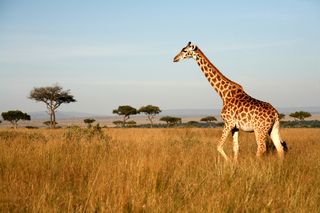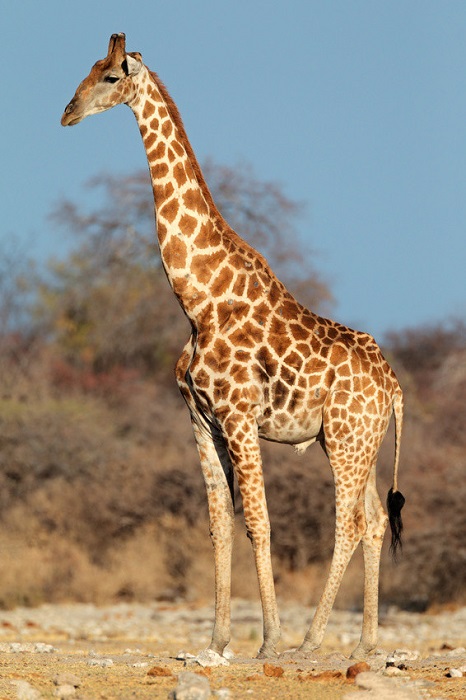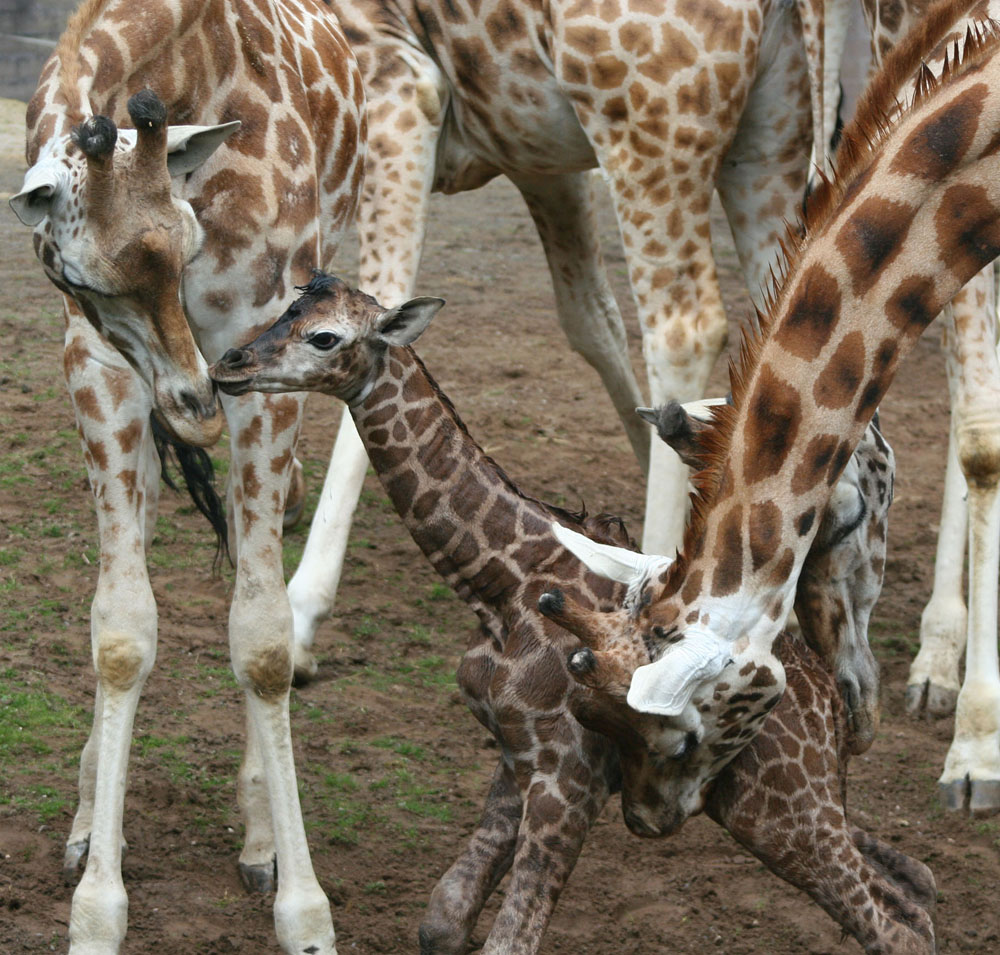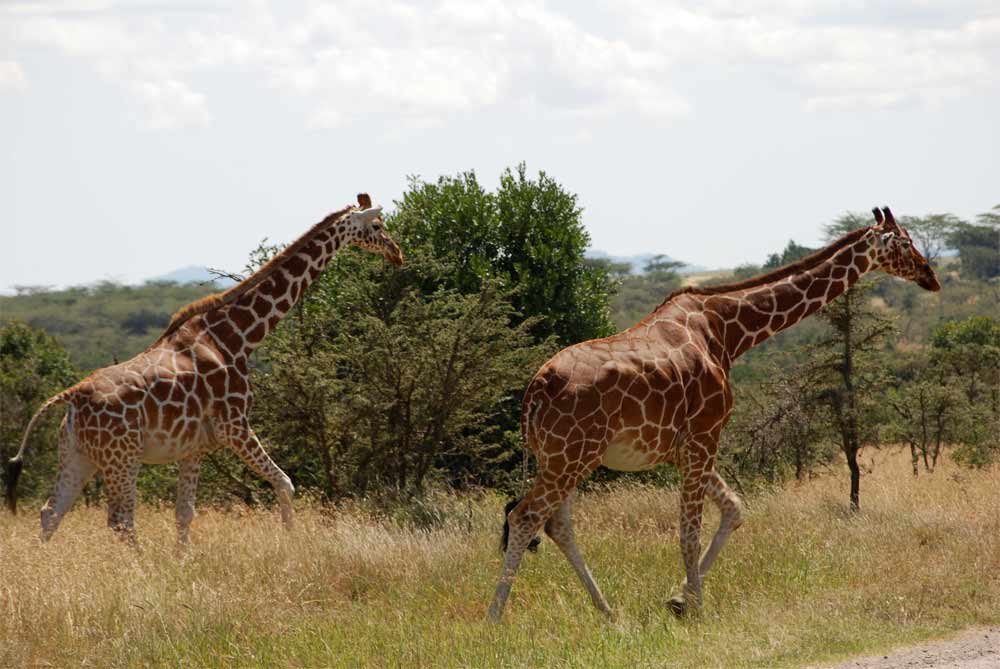Channel 4 News Name the Baby Giraffe Contest
Giraffe Facts & Photos

Giraffes tower over Africa's plains. These tall animals are identified past their long necks, equally long and spindly legs, and spotted coats. Most giraffes have a tan, white or yellow coats that are spotted with brownish, foursquare shapes.
Size
Giraffes are the tallest living animals in the world, according to the Smithsonian National Zoological Park. A giraffe'due south neck alone is half-dozen feet (1.8 meters) long and weighs about 600 lbs. (272 kilograms). The fauna's legs are also half dozen feet long.
Females grow upwards to 14 feet (4.3 k) tall and weigh up to one,500 lbs. (680 kg), while males grow up to 18 anxiety (5.5 m) tall and weigh up to 3,000 lbs. (1,360 kg).

With such a massive torso, it makes sense that the giraffes' organs and other torso parts are equally huge. Their tongues are a substantial 21 inches (53 centimeters) long, and their feet are 12 inches (30.5 cm) across. According to the San Diego Zoo, a giraffe'southward centre is 2 feet (0.6 m) long and weighs almost 25 lbs. (11 kg). Their lungs can hold 12 gallons (55 liters) of air. In comparing, the average total lung capacity for a human being is 1.59 gallons (6 liters).
Habitat
Giraffes alive in savannas throughout Africa. The tall creatures are native to Kenya, Republic of cameroon, Chad, Niger, Uganda, Namibia, Botswana, Zimbabwe, Republic of zambia, Tanzania, Angola and Southward Africa, according to the Earth Atlas.They like semi-arid, open woodlands that have scattered trees and bushes, making the savannas perfect for these animals.
Habits
Giraffes are so social that they don't take territories. A group of giraffes is aptly called a tower, according to the U.Due south. Geological Survey. Towers typically have ten to xx members. Who lives in the belfry can vary. Some towers consist of all females and their young, or all male or mixed genders. Member are gratis to come and go equally they delight, according to the Animal Variety Spider web.
Giraffes merely sleep around xx minutes or less per 24-hour interval, according to PBS Nature. Staying awake nearly of the fourth dimension allows them to be constantly on alert for predators. They usually get their sleep in quick power naps that last just a couple of minutes.
Every giraffe has two pilus-covered horns chosen ossicones. Male giraffes use their horns to playfully fight with one another. They also spar by swinging their heads at one another and entwining their necks, which is called "necking." [Images: Animals' Dazzling Headgear]
Diet
Giraffes are herbivores, which ways they eat only plants. Their long necks permit them to accomplish leaves, seeds, fruits, buds and branches high up in mimosa and acacia trees. They can eat hundreds of pounds of leaves per week, according to National Geographic.
Though these animals swallow a lot, giraffes tin can get without drinking for weeks at a time. They get about of their moisture from the vegetation they eat.
Offspring

Equally in cattle, female giraffes are chosen cows, while the males are chosen bulls. Afterwards mating, the moo-cow will take a gestation period of around xiv months. Baby giraffes are called calves. During birth, the dogie will drop to the ground, since mother giraffes requite nascence standing up. The fall can be as far every bit v feet (1.v one thousand), co-ordinate to National Geographic.
New calves are quite large, at vi feet tall (1.8 m), 100 to 150 lbs. (45 to 68 kg), according to the San Diego Zoo. They are also agile. At just an hour after birth, they can stand upwards and walk around.
Giraffe mothers often have turns watching over the calves. Sometimes, though, the mother giraffe will leave the calf by itself. When this happens, the infant will lie down and wait for its mother to render.
Calves are weaned at effectually 12 months, according to the Academy of Michigan. At 3 to six years sometime, calves are fully mature. The animals tin can live 10 to 15 years in the wild and 20 to 25 years in captivity.
Classification/taxonomy
In the Giraffidae family, there are ii genera:Giraffa andOkapia. The okapi is sometimes called the forest giraffe. The Giraffa genus has recently had a milkshake-up later a recent study recognized 4 species, not just ane.
The 2016 written report was published in the periodical Current Biology. Researchers from the Giraffe Conservation Foundation (GCF) nerveless and analyzed Deoxyribonucleic acid from pare samples representing 190 giraffes from across Africa, the starting time such analysis to include information from all nine formerly accepted subspecies. [Related: i Long Neck, four Species: New Giraffe Diversity Revealed]
The new taxonomy of giraffes, according to the GCF, is:
Kingdom: Animalia Subkingdom: Bilateria Infrakingdom: Deuterostomia Phylum: Chordata Subphylum: Vertebrata Infraphylum: Gnathostomata Superclass: Tetrapoda Class: Mammalia Bracket: Theria Infraclass: Eutheria Society: Artiodactyla Family:Giraffidae Genus:Giraffa Species:
- Giraffa giraffa (southern giraffe), with two subspecies:G. g. angolensis (Angolan giraffe) andG. g. giraffa (South African giraffe)
- Giraffa camelopardalis (northern giraffe), with three subspecies:M. c. antiquorum (Kordofan giraffe),Thou. c. camelopardalis (Nubian giraffe) and1000. c. peralta (West African giraffe)
- Giraffa reticulate (reticulated giraffe)
- Giraffa tippelskirchi (Masai giraffe)
Conservation status

Recognizing iv distinct giraffe species should exist a game changer for conservation plans, the GCF researchers said in the study.
Fewer than 100,000 giraffes remain in the wild, down from an estimated 150,000 that roamed the savannas thirty years ago. And because the species don't interbreed, population numbers for all African giraffes won't accurately represent whether each group is doing well. Using this new information about giraffe genetics, governments and biologists can create more than focused efforts to ensure that all 4 species will be neck and neck in their race toward future success, the scientists said.
Giraffe populations are challenged because of poaching and shrinking habitat. The animals' tails are fabricated into good-luck bracelets, fly whisks and thread for stringing beads, co-ordinate to the African Wildlife Foundation. Equally agricultural settlement expands, the giraffe's main source of nutrient, the acacia tree, is being cut downwards.
Other facts
Merely like human fingerprints and zebra stripes, the coat design of a giraffe is unique to that animal.
The pattern and the small-scale hump on a giraffe's back are similar to those of a leopard. Years agone, many people thought the giraffe was a combination of a camel and a leopard, and they chosen these animals "camel-leopards."
You will often meet giraffes walking around with birds on their backs. These birds are called tickbirds, or oxpecker birds (Buphagus africanus). They eat bugs that live in the giraffe's coat and warning the animals to danger by chirping loudly.
Even if you spent a lot of time with giraffes, you would never hear them make a dissonance. This is because giraffes communicate using noises that are too depression for humans to hear, according to PBS Nature.
Thanks to their long legs, giraffes are very fast. They tin run 35 mph (56 km/h) in short bursts and run for longer stretches at ten mph (sixteen km/h), according to National Geographic.
Giraffes are fifty-fifty-toed ungulates, which means they have two weight-bearing hooves on each human foot, and are in the order Artiodactyla, which also includes antelopes, cattle, goats, sheep, caribou, moose, hippos and pigs.
Additional Resources
- San Diego Zoo: Giraffes
- Giraffe Conservation Foundation
- Animal Diversity Spider web: Oxpecker Bird (Buphagus africanus)
This article was updated on Sept. 15, 2020 to add the countries in Africa giraffes are native to.
Source: https://www.livescience.com/27336-giraffes.html

0 Response to "Channel 4 News Name the Baby Giraffe Contest"
Enregistrer un commentaire